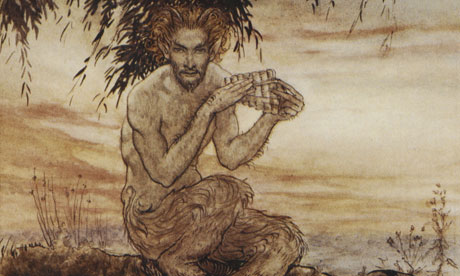
If you can't remember the bit in The Wind in the Willows when Mole and Rat go searching for a missing baby otter, only to find him asleep in the hooves of the muscular, horned god Pan, then you're not alone. "It is the chapter that everyone forgets about it," said Jamie Andrews of the British Library. "For most editions it's left out."
Kenneth Grahame's handwritten version of the chapter, together with illustrations by Arthur Rackham, will though be part of a summer exhibition at the library called Writing Britain: Wastelands to Wonderlands, details of which were announced on Tuesday.
The chapter – The Piper at the Gates of Dawn – is normally dropped because it jars, seems so strange compared to all the others and, to some, is vaguely homo-erotic. Grahame thought it essential.
The library said The Wind in the Willows would be one of more than 150 literary works to feature in a show that aims to explore how writers in Britain, from Geoffrey Chaucer and William Shakespeare to Angela Carter and Hanif Kureishi, have been inspired by and helped shape our understanding of landscape and place.
Curators have delved into the library's vast collection and chosen exhibits that include one of Samuel Taylor Coleridge's Lake District notebooks; the poetic/photographic celebration of the Calder Valley by Ted Hughes and Fay Godwin; and Laurie Lee's handwritten manuscript of Cider with Rosie, his autobiographical account of growing up in Slad, Gloucestershire.
The show will reveal some unlikely connections, for example between the very different writers JG Ballard and GK Chesterton who both explored London gated communities and the potential for violence therein with works a century apart (Ballard's 2003 novel Millennium People and Chesterton's 1908 work The Man Who Was Thursday).
Andrews, the show's lead curator and head of English and drama at the library, said: "We think that every item here will connect to another in some way and the best thing is, sometimes the connections will be obvious – Ted Hughes and Sylvia Plath to the Brontes say – and sometimes they won't, like Ballard and Chesterton.
"We'd like to think everyone can have an individual experience navigating their own connections."
Andrews conceded they were choosing from millions of things. "We know we're leaving things out. We're trying to choose things we know that, on their own, are redolent and exciting but they also add up to a larger whole – they spark these connections."
Because the library can only paint a partial picture it will launch an online initiative inviting people to make their own contributions – whether that is saying who wrote the definitive novel for Milton Keynes, or who created the great ode to Didcot. "We want to create this literary map of Britain, where every space and place is in some way linked to a literary text. We can't do that but we believe it must be possible to do."
The exhibition will span 1,000 years of creative writing and include sound recordings, letters, photographs, drawings and song lyrics as well as yet to be revealed contributions from contemporary writers.
The show will be part of the Cultural Olympiad and the London 2012 Festival and will run from 11 May - 25 September.

